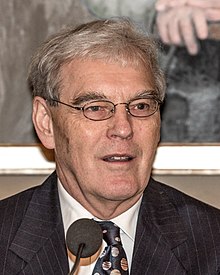Richard Henderson
Richard Henderson , CH (born July 19, 1945 in Edinburgh , Scotland ) is a British structural and molecular biologist . In 2017 he received the Nobel Prize in Chemistry together with Jacques Dubochet and Joachim Frank .
Life
Henderson earned a bachelor's degree in physics from Edinburgh University in 1966 and a Ph.D. from Cambridge University in 1969. in molecular biology . In 1969/1970 he worked as a research assistant for the Laboratory of Molecular Biology (LMB) of the Medical Research Council (MRC) in Cambridge before working as a postdoctoral fellow at Yale University between 1970 and 1973 . Henderson spent his further scientific career at the LMB, most recently (1986-2006) as the successor to Aaron Klug as head of the department. Under Henderson's direction, up to 400 people worked in the LMB at the same time. Among them were the Nobel Prize winners César Milstein , Georges Köhler and John E. Walker .
Act
Henderson is considered a pioneer of electron microscopy in determining the molecular structure of membrane proteins . He could high-resolution (7 angstroms ) maps the structure of bacteriorhodopsin create, by means of which it is a detailed mechanism of this proton pump might suggest, the first insight into how the proteins of membrane transport .
Together with Nigel Unwin and building on the work of Aaron Klug and Jacques Dubochet explored Henderson at Laboratory of Molecular Biology (LMB) of the Medical Research Council , various membrane proteins, with Unwin on ion channels concentrated and Henderson to proteins consisting of seven α-helices exist , including the bacteriorhodopsin and the G-protein coupled receptor . While Henderson began his scientific career with X-ray crystallography (the Henderson limit was named after him), the switch to electron microscopy offered the advantage of being able to examine a protein crystal that consists of only about 5,000 molecules - there are four for X-ray crystallography up to five powers of ten larger crystals are required. His work on bacterial rhodopsin in 1990 was the first electron microscopic image of a protein in atomic resolution.
Further work by Henderson deals with the improvement of electron microscopic technology in order to ultimately be able to analyze membrane molecules in non-crystalline form.
Awards (selection)
- 1980 Ernst Ruska Prize for Electron Microscopy from the German Society for Electron Microscopy (with Nigel Unwin )
- 1983 Member (Fellow) of the Royal Society
- 1991 Rosenstiel Award (with Nigel Unwin )
- 1993 Louis Jeantet Prize (with Jean-Pierre Changeux and Kurt Wüthrich )
- 1998 Member (Foreign Associate) of the National Academy of Sciences
- 1999 Gregori Aminoff Prize for Crystallography from the Royal Swedish Academy of Sciences
- 2003 Honorary Member of the British Biophysical Society (BBS)
- 2016 Alexander Hollaender Award in Biophysics
- 2016 Copley Medal from the Royal Society
- 2017 Gjønnes Medal in Electron Crystallography
- 2017 Wiley Prize in Biomedical Sciences
- 2017 Nobel Prize in Chemistry
- 2018 Glenn T. Seaborg Medal
literature
- István Hargittai: Richard Henderson. In: Candid Science II. Conversations with Famous Biomedical Scientists. World Scientific Publishing 2002, ISBN 1-86094-280-6 , pp. 296-305
Web links
- Working group , curriculum vitae and biographical note at the Medical Research Council (UK) (mrc-lmb.cam.ac.uk); Retrieved July 14, 2011
Individual evidence
- ↑ Publication: Henderson, JM Baldwin, TA Ceska, F. Zemlin, E. Beckmann, KH Downing, Model for the structure of bacteriorhodopsin based on high-resolution electron cryo-microscopy, J. Mol. Biol., Volume 213, 1990, Pp. 899-929, PMID 2359127
- ↑ Ernst Ruska Prize of the German Society for Electron Microscopy (dge-homepage.de); Retrieved July 14, 2011
- ^ Fellows of the Royal Society (royalsociety.org); Retrieved July 14, 2011
- ^ Past Winners - Rosenstiel Award - Rosenstiel Basic Medical Sciences Research Center - Brandeis University. In: brandeis.edu. Retrieved January 23, 2016 .
- ↑ Doctor Richard HENDERSON in Louis-Jeantet Foundation (jeantet.ch); accessed on May 10, 2019.
- ^ Richard Henderson at the Royal Swedish Academy of Sciences (kva.se); Retrieved July 14, 2011
- ↑ About the BBS ; accessed on May 10, 2019.
| personal data | |
|---|---|
| SURNAME | Henderson, Richard |
| BRIEF DESCRIPTION | British structural and molecular biologist |
| DATE OF BIRTH | July 19, 1945 |
| PLACE OF BIRTH | Edinburgh , Scotland |
